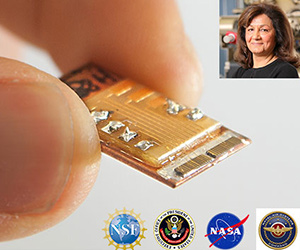Razeghi Makes Major Advancements in Terahertz Radiation
Prof. Manijeh Razeghi has been quoted in a recent article discussing her research that led to creating a compact terahertz radiation source, which can operate at room temperature.
Prof. Manijeh Razeghi has been quoted in a recent article discussing her research that led to creating a compact terahertz radiation source, which can operate at room temperature. The practical applications of this device are vast and include: security screening, medical, and deep space imaging.
Excerted from an Thursday, November 20, 2014 article published by McCormick, titled, "New Terahertz Device Could Strengthen Security."
 We are all familiar with the hassles that accompany air travel. We shuffle through long lines, remove our shoes, and carry liquids in regulation-sized tubes. And even after all the effort, we still wonder if these procedures are making us any safer. Now a new type of security detection that uses terahertz radiation is looking to prove its promise. Able to detect explosives, chemical agents, and dangerous biological substances from safe distances, devices using terahertz waves could make public spaces more secure than ever.
We are all familiar with the hassles that accompany air travel. We shuffle through long lines, remove our shoes, and carry liquids in regulation-sized tubes. And even after all the effort, we still wonder if these procedures are making us any safer. Now a new type of security detection that uses terahertz radiation is looking to prove its promise. Able to detect explosives, chemical agents, and dangerous biological substances from safe distances, devices using terahertz waves could make public spaces more secure than ever.
But current terahertz sources are large, multi-component systems that sometimes require complex vacuum systems, external pump lasers, and even cryogenic cooling. The unwieldy devices are heavy, expensive, and hard to transport, operate, and maintain.
“A single-component solution capable of room temperature and widely tunable operation is highly desirable to enable next generation terahertz systems,” said Prof. Razeghi.
Director of Northwestern’s Center for Quantum Devices, Razeghi and her team have been working to develop such a device. In a recent paper in Applied Physics Letters, they demonstrate a room temperature, highly tunable, high power terahertz source. Based on nonlinear mixing in quantum cascade lasers, the source can emit up to 1.9 milliwatts of power and has a wide frequency coverage of 1 to 4.6 terahertz. By designing a multi-section, sampled-grating distribution feedback and distributed Bragg reflector waveguide, Razeghi and her team were also able to give the device a tuning range of 2.6 to 4.2 terahertz at room temperature.
Funded by the National Science Foundation, Department of Homeland Security, Naval Air Systems Command, and NASA, the device has applications in medical and deep space imaging as well as security screening.
“I am very excited about these results,” Razeghi said. “No one would believe any of this was possible, even a couple years ago.”
